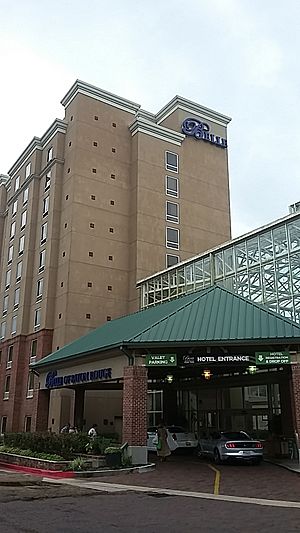Belle of Baton Rouge facts for kids
Quick facts for kids Belle of Baton Rouge |
|
|---|---|
 |
|

The entrance of the Belle of Baton Rouge hotel
|
|
| Location | Baton Rouge, Louisiana |
| Address | 103 France Street |
| Opening date | September 30, 1994 |
| No. of rooms | 288 |
| Total gaming space | 28,500 sq ft (2,650 m2) |
| Casino type | Riverboat |
| Owner | Gaming and Leisure Properties |
| Operating license holder | Caesars Entertainment |
| Previous names | Argosy Catfish Queen |
The Belle of Baton Rouge is a fun riverboat casino and hotel located in Baton Rouge, Louisiana. It's owned by Gaming and Leisure Properties and run by Caesars Entertainment. This exciting place offers games, a hotel, and even hosts cool events!
Contents
What's Inside the Belle of Baton Rouge?
The Casino Boat
The casino part of the Belle of Baton Rouge is on a special boat! It's a 268-foot (82 m) long boat with four decks, like floors. It's called a sternwheeler, which means it has a big paddle wheel at the back to move it through the water.
Inside the boat, there's a huge area for games, about 28,500 square feet (2,650 m2) big. This space is spread across three decks. You can find 777 slot machines here, which are games where you put in coins and try to match symbols. There are also 14 table games, like blackjack or poker, where you play against a dealer or other players.
The Hotel and Other Fun Spots
Right next to the casino boat is a tall, 10-story hotel. It has 288 rooms, a swimming pool where you can splash around, and a fitness center if you like to exercise.
There's also a giant glass building called an atrium. It's 50,000-square-foot (4,600 m2) big and five stories tall! Inside this amazing glass building, there's a special stage for performances. Many cool events have happened here, like concerts, mixed martial arts (MMA) fights, and even nationally televised boxing matches.
The Belle of Baton Rouge also has meeting rooms, three places to eat yummy food, and two parking garages for cars.
A Look Back: The Belle's History
Catfish Town: Where It All Began (1984–1992)
The area where the Belle of Baton Rouge is now located used to be a historic warehouse district called Catfish Town. In 1984, it was turned into a special shopping and entertainment area. People hoped it would be a popular spot, but it was hard to get enough shops and visitors.
By 1987, the original owners decided to sell it. The property changed hands a few times. In 1991, Louisiana made it legal to have riverboat casinos. This made Catfish Town a very interesting place for companies that wanted to open a casino!
Building the Belle (1993–2001)
When Louisiana allowed riverboat casinos, there was a lot of excitement. The state decided to allow up to 15 casino licenses, and they had to be on certain rivers, like the Mississippi River. In Baton Rouge, city leaders wanted only one casino, but the state decided to allow two.
A company called Jazz Enterprises wanted to build a casino at Catfish Town. They planned to buy the land and spend a lot of money to make it better. They also added a 400-room hotel to their plans. The city leaders liked their idea, and the state gave them a first approval in 1993. Another casino, which later became Hollywood Casino Baton Rouge, also got a license.
Later, a company called Argosy Gaming joined the project. They decided to change the casino's name from Catfish Queen to the Belle of Baton Rouge. Argosy liked to use "Belle" in the names of their casinos.
After some more steps, the Belle of Baton Rouge finally received its official license in July 1994. The casino opened its doors on September 30, 1994, ready for visitors!
In 1995, Argosy Gaming bought Jazz Enterprises, taking full ownership of the Belle and Catfish Town. This helped solve some issues with the city and allowed construction to continue.
New parts of the property opened over time. A building with a bar, gift shop, and restaurant opened in 1995. The big glass atrium, called the Argosy Festival Atrium, opened in 1996. In 1999, the casino's name was changed to Argosy Casino Baton Rouge.
The hotel construction finally started in 1999 and was finished in February 2001. It opened as the Sheraton Baton Rouge Convention Center Hotel.
Changes Over Time (2002–Present)
In 2004, another company, Penn National Gaming, wanted to buy Argosy Gaming. But Penn National already owned another casino in Baton Rouge, and owning both would mean they had a monopoly (meaning they would be the only casino in town). To get approval, Penn National agreed to sell the Argosy Baton Rouge.
In 2005, a company called Columbia Sussex bought the casino for $150 million. After this sale, the property's name was changed back to the Belle of Baton Rouge.
The hotel stopped being a Sheraton in 2010. In 2011, the Belle of Baton Rouge got a $7 million makeover to make it even better and more modern.
In 2018, the land and buildings of the Belle of Baton Rouge were bought by Gaming and Leisure Properties. The company that runs the casino business, Eldorado Resorts (which later became Caesars Entertainment), now leases the property from Gaming and Leisure Properties.
In 2020, Caesars agreed to sell the casino's operations to CQ Holdings.
Sports
Boxing Matches
The Belle of Baton Rouge has also been a place for exciting sports events. On November 30, 2013, a boxing match took place there. Boxer Regis Prograis fought Miguel Alvarez, and Prograis won the fight in the third round!

